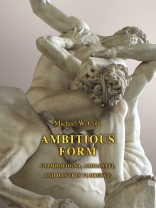Ambitious Form describes the transformation of Italian sculpture during the neglected half century between the death of Michelangelo and the rise of Bernini. The book follows the Florentine careers of three major sculptors–Giambologna, Bartolomeo Ammanati, and Vincenzo Danti–as they negotiated the politics of the Medici court and eyed one another’s work, setting new aims for their art in the process. Only through a comparative look at Giambologna and his contemporaries, it argues, can we understand them individually–or understand the period in which they worked.
Michael Cole shows how the concerns of central Italian artists changed during the last decades of the Cinquecento. Whereas their predecessors had focused on specific objects and on the particularities of materials, late sixteenth-century sculptors turned their attention to models and design. The iconic figure gave way to the pose, individualized characters to abstractions. Above all, the multiplicity of master crafts that had once divided sculptors into those who fashioned gold or bronze or stone yielded to a more unifying aspiration, as nearly every ambitious sculptor, whatever his training, strove to become an architect.
关于作者
Michael W. Cole is professor of art history at Columbia University. He is the author of
Cellini and the Principles of Sculpture and the coeditor of
The Idol in the Age of Art, among other books.












